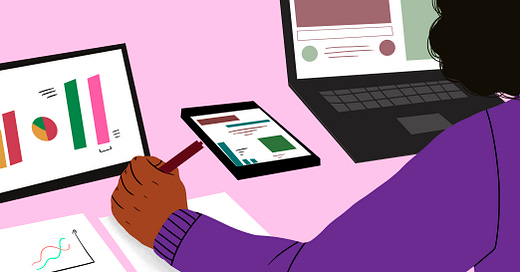I recently came across an old clip of myself on a podcast called Creative Rebels with
, recorded back in 2019. (I'd just turned 30! Now I'm turning 36 next week!) Naturally, I look and sound different; six years feels like a weirdly long time. It was pre-pandemic, I was still living in my old flat, I hadn’t gotten married yet, my main job was hosting a careers podcast, and my first novel Olive was about to be published.But as I listened to what I was saying, I found myself nodding along.
“It’s a really exciting time for creators—there are so many things we can try,” I say in the clip. Then I stumble over the name Substack (calling it “Stub-Stack” at first) saying that maybe there could be a “Netflix” type model for writers. I go on to say, “I’d love to try a new model like this”—something that doesn’t depend entirely on advertising to keep going. Back then, I was running a podcast funded by ads. Now, I write a Substack that’s supported entirely by you, my readers.
This seems to happen a lot—I look back at old clips or writing, and realise I was unknowingly predicting my own future.
Earlier this week, I interviewed Substack’s co-founder Hamish McKenzie on one of the main stages at SXSW London, the three-day business-tech-culture festival that took over Shoreditch. Every other person on the street seemed to be wearing a neon pink lanyard, and the sun was shining. As many of you know, I spent quite a bit of time laying low these past few years, but being back on stage again—in a leopard print suit no less—felt great.
I was genuinely excited to interview Hamish. Unlike other tech figures (we know which ones) Hamish is a writer and former journalist who seems genuinely committed to shifting power back to writers and creators. Substack’s motto is “we make money when you make money”—they take a 10% cut of your revenue—which creates a sense of integrity and transparency. Writers keep the majority of their earnings, and the platform only succeeds if they do.
For years, we’ve normalised sharing our life and work (or dare I say: “personal brand”) on social media for free. Many people earn money through ads or brand deals—a business model I personally always found unstable (and a bit strange tbh: your energy and vibe is essentially being ‘bought’ temporarily by a brand.) With paid subscribers via a newsletter, there are no middlemen; you’re writing directly for your audience. I find that shift fascinating and freeing.
There’s also been a bit of a shift recently. Substack doesn’t seem to be ‘mainstream’ yet—but organisations like New York Magazine, Billboard and BBC History have all joined Substack. As
recently said: first they hate you, then they join you. 😆The interview wasn’t recorded. The room was full, 300 people in the auditorium, and we only had 25 minutes. It went by in a flash. Here’s a few things I remember from the discussion:








